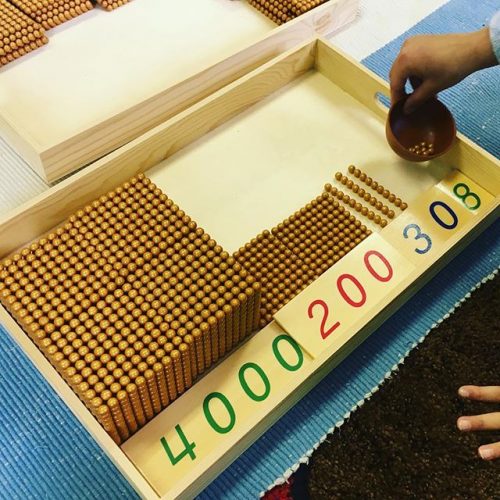
Learning Math at Seeds and Roots Montessori
The mathematics materials help the child learn and understand mathematical concepts by working with concrete materials.
It uses a general approach of introduction, practice and application.

First Stage

Second Stage

Third Stage

Fourth Stage
The Montessori Number Work Progression is divided into 6 major parts namely:
- Introduction to Numbers 0 to 10
- Introduction to the Decimal System
- Work with teens and tens
- Memory Work
- Passage to Abstraction
- Fractions

The math materials introduce the child to the quantities, and later on the symbols, 1 – 10. The child is then given the opportunity to relate his knowledge of quantity and symbol with the number rods and cards. The spindle boxes clarify the idea that a quantity is made up of separate quantities and introduces zero as no quantity. The memory game and cards and counters serve as practice for the child as he is required to remember and associate quantity to symbol. The cards and counters provide practice for the sequence of numbers and also introduce odd and even numbers. The child may continue to learn the quantities and symbols for numbers succeeding 10 thus moving on to work with teens and tens.
Another Montessori approach is to present work with the golden bead material, introducing the decimal system. The categories of the decimal system (units, tens, hundreds, thousands) and their numerical symbols are presented. With the golden bead material, exercises for the 4 mathematical operations are introduced. With these exercises, the child is presented with a geometric representation of the quantities as well as a concrete and sensorial understanding of the process involved in each arithmetic operation. Simultaneously, the child may also be presented with linear counting exercises.
To reinforce his experience with the golden bead material, the stamp game for the 4 operations are given as follow-up exercises. The child is now moving to more abstract work. Instead of working with “geometrically” represented quantities, he is now dealing with stamps of the same kind, varying only in color and in the numbers printed on them. The child is also encouraged to write down the problems and answers on paper.
The child then moves on to memory work. The Montessori approach attempts to make this task less tedious and more meaningful for the child. The child is given only the basic unit combinations of each operation to memorize. The approach begins with concrete materials such as the snake game for both addition and subtraction.
Follow-up work with the strip boards are then presented. Work then moves on to variations of finger charts where the child is given the opportunity to memorize the unit combinations through repetition. In addition, work with the half chart brings the child to a realization of the commutative property, where he realizes that he only needs to memorize half as much combinations. This helps sustain the child’s interest for memory work.

As the child gains mastery over the previous material, the child moves on to exercises that will help him towards his passage to abstraction in mathematics. The goal is to have the child do mathematical operations solely on paper. The child is given the link between the materials, such as the small bead frame for addition and subtraction, and paperwork. The materials bring to the child’s awareness that he has already acquired the knowledge he needs to perform the operations and no longer needs the materials to do so.
Through this number work progression, the child moves from a concrete impression to an understanding of abstract mathematical concepts, which enables him to mentally perform mathematical operations on paper with understanding and ease.

